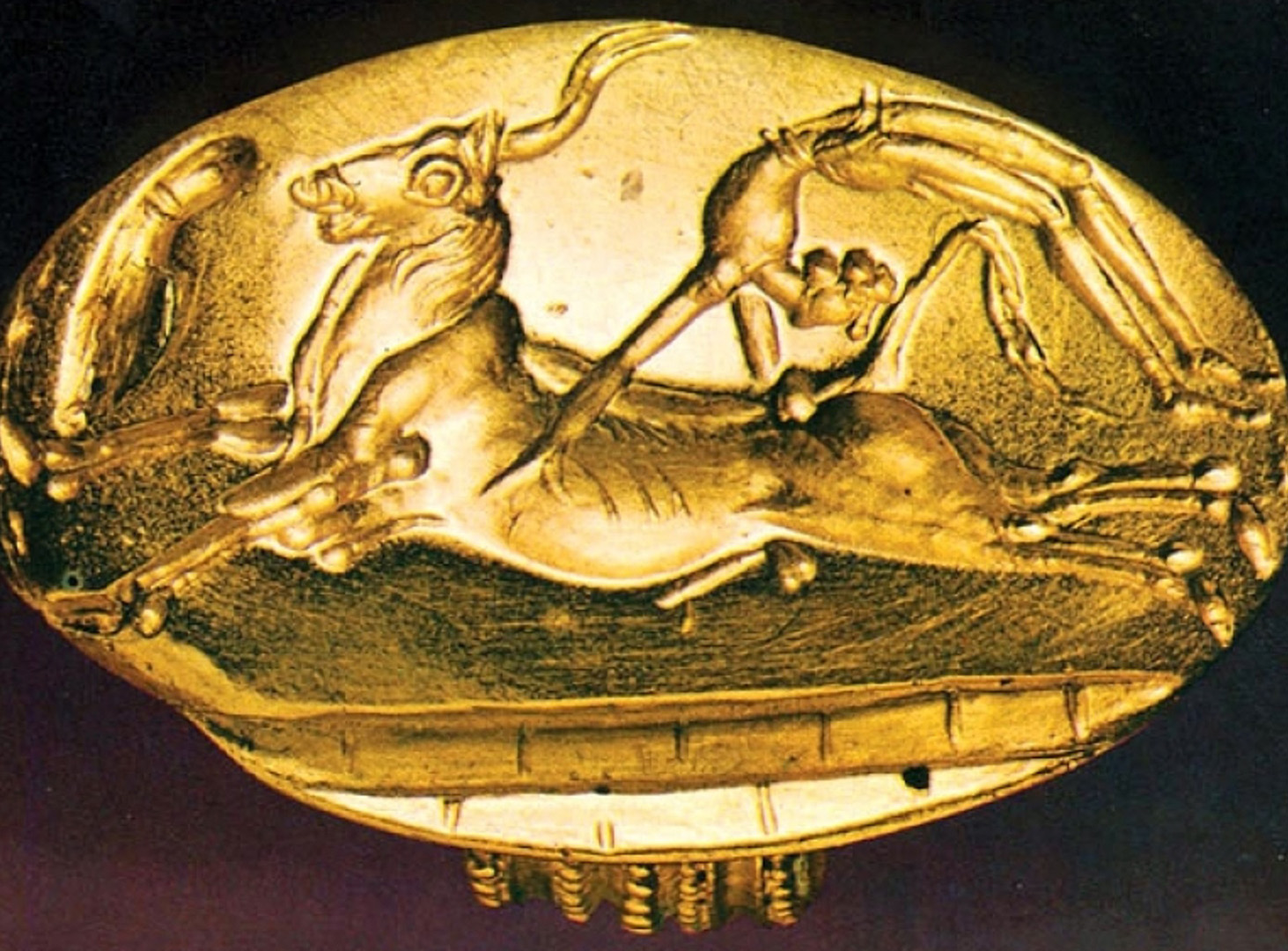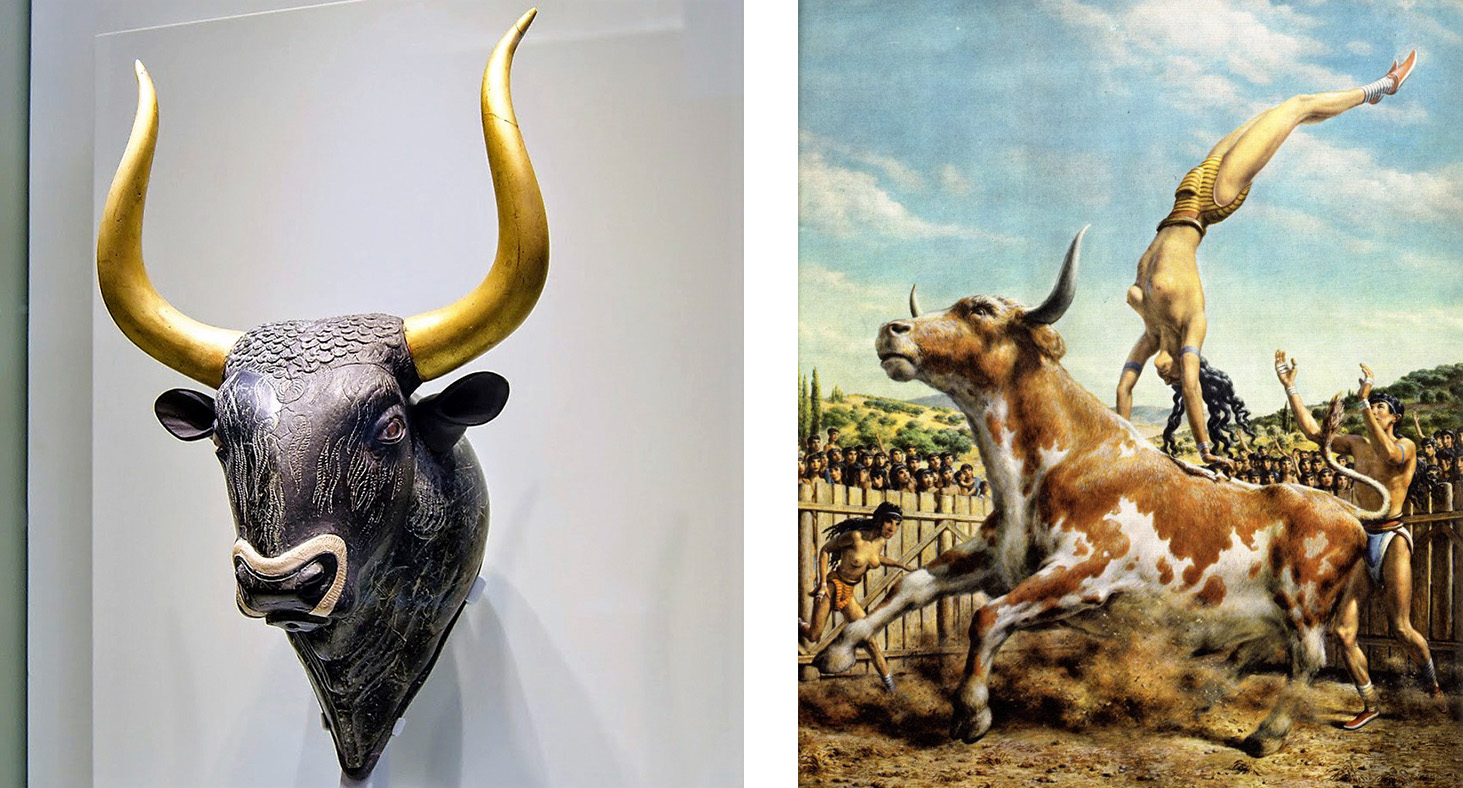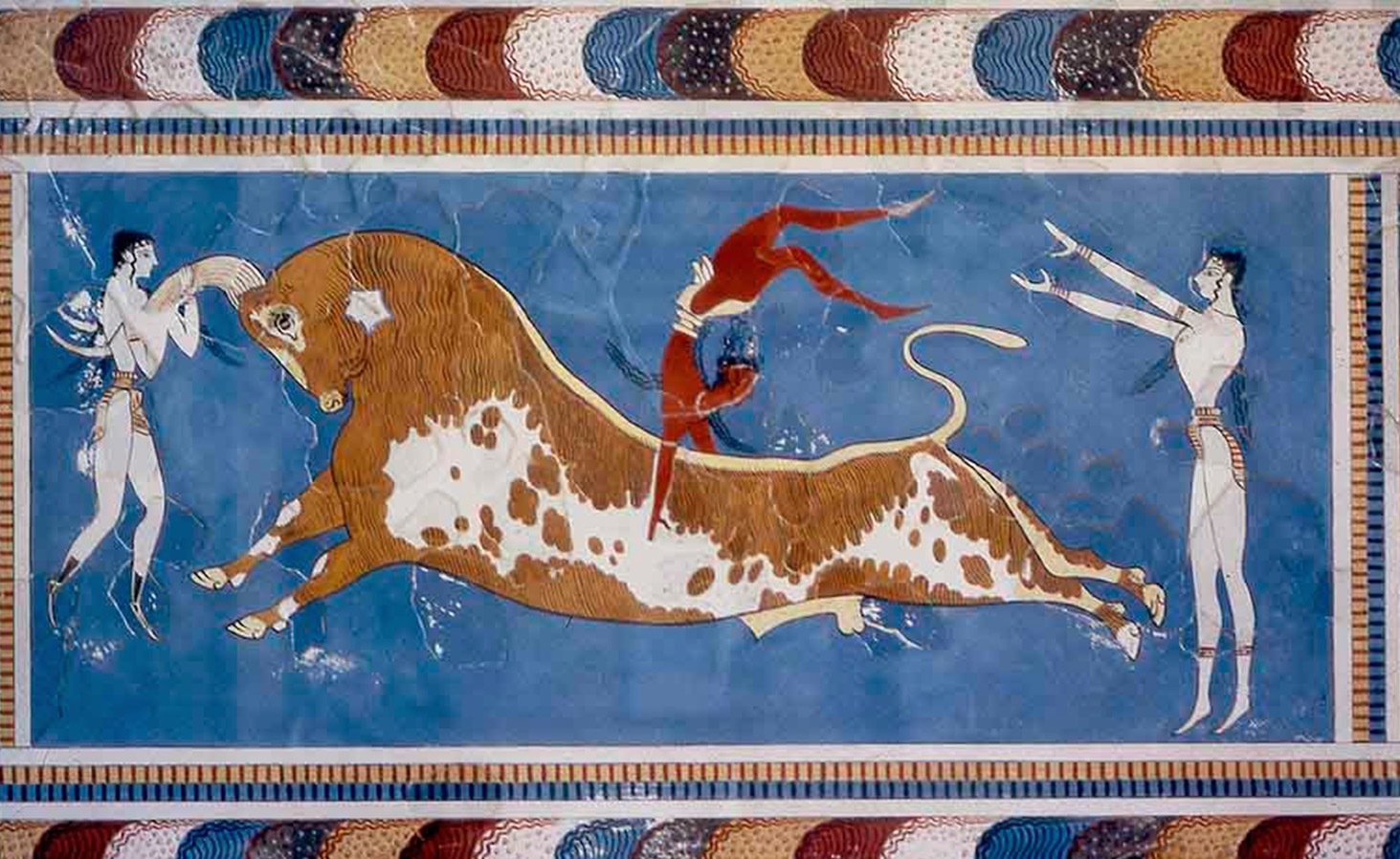Bull cult


As you know, there is a myth about a monster with a bull’s head, lived in the Labyrinth, a son of a bull and the wife of the Cretan king Minos, result of an unnatural connection. He was killed by the Athenian Theseus. The myth is associated with the Minoan culture that existed in Crete from 2700 to 1400 BC.
In the third century BC., Plutarch reported in the life story of Theseus that the Cretans rejected this legend. He also cites information (from various historians), from which it can be concluded that King Minos had a warlord named Taurus (bull in Greek) who died in the war with the Athenians, and other details were apparently a product of myth-making, as scholars of late antiquity believed.
Modern historians, however, say that in ancient times there existed a bull cult, which was prevalent in almost the entire Eastern Mediterranean. The evidences of this are the frescoes of the II millennium BC. in the palace of Knossos on Crete. One of such evidences is oral legend of the Minotaur.
Some of the modern customs in Spain are relics of an understanding that the bull was a sacred animal, which caused ritual eating it. So, until recently, they organize an annual battle with a bull in Tordesillas (Valladolid province), after which all those present ate the killed bull. In some cities in Spain there are games with young bulls, which are held during the big rural holidays. In many places in Spain, fights between bulls are organized; and in Navarre there are races on the streets, through which a herd of young bulls is driven: a crowd of brave men runs ahead. From ancient Spain, there are many images of a bull, a sacred animal for the population of that time: here we must remember that they plowed using oxen. The horse replaced them only after the invention of the horse collar in the V century. Presumably, the traditional bullfight in Spain is a legacy of this cult, which they do not want to give up, despite constant protests in Europe.

The most ancient description of a man-bull contest is contained in the Sumerian epic about Gilgamesh. Sumerians appeared in Mesopotamia in the second half of the 4th millennium BC.
A very interesting ritual is the bull-leaping, depicted on the famous fresco of the Great Palace at Knossos where Minoan «acrobats» jumped over the bull. It has some similarity with a competition of young boys and girls with a bull, which required special dexterity and courage, as it was necessary to grab the animal by the horns, make a double pike over its body and land behind it. The meaning of the game with the bull is not quite clear. It can be some kind of religious rite. Perhaps its main purpose was curbing the terrible force of the earthquake. Apparently, the divine bull was perceived by the Minoans also as the embodiment of the destructive forces of nature. The same images of bull-leaping were depicted on a vessel found by archaeologists during the excavation of an ancient Hittite settlement on Hüseyindede Hill in Central Anatolia (Chorum province, Turkey) and on a cylindrical seal in Alalakh, an ancient Amorite city-state (Tell Atchana) founded around 2000 BC and located 15 miles east of present-day Antakya (a city in southeastern Turkey at the site of ancient Antioch). However, if we would associate the bull cult with earthquakes, then in Crete happened many of them. After the largest earthquake on July 21, 365, the island was lifted by 10 yards. Its consequences can now be seen in the ancient town of Phalasarna, in the north-west of the island; and whole ancient Anatolia is generally covered with traces of ruins from ancient earthquakes.

Talking about Antioch, we can mention the earthquake of December 13, 115. Two Roman emperors turned then in this half-million city: Trajan, less than two years before his death, and Hadrian who accessed after him. The Romans headquartered in Antioch during a war with Parthia. Both were lucky enough to survive. Trajan climbed through a window of the room in which he was: someone, taller than a man, approached him and led him outside, so that the emperor received only a few minor injuries; and since the tremors continued for several days, he lived on the hippodrome field. Many soldiers, including members of the imperial suite, died: in total, 260,000 people died at the time of the earthquake and the following days. The same happened there in 526, when 250,000 people died; and in the above-mentioned province of Chorum, where is, by the way, the mathematical center of the surface of our planet, the last earthquake occurred on November 2, 2016.
The bull cult was widespread in Anatolia. In the northeast of modern Turkey, the peasants arrange bullfights now in the spring, and the ones have already become an established tradition. The fact that the cult of bullfighting existed in antiquity almost throughout the Mediterranean is also testified by a similar custom among residents of Western Georgia (in Muslim Adjara, adjacent to northeastern Turkey) who also arrange them in spring on the occasion of the celebrations on the eve of planting: that is, a typical agricultural tradition. In Mingrelia, in Orthodox Georgia, man-bull contests were held. This is somewhat closer to the images of the fresco on Crete, testifying to the antiquity of this custom.
A separate topic is the tauroctony (“the killing of the bull”), the depiction in Mithraism of the central cult scene — the killing of bull by Mithras, which appeared from the period of cult’s spread in Hellenistic states, when its content was filled with astrological sense (II century BC). Citing the fact that the study of the ancient cult of Mithras of the pre-Hellenic era did not reveal the myth of Mithras and the bull, some modern scholars argue that the tauroctony is an evidence of a new religion, which appeared in Asia Minor. It combined fatalistic ideas about the predestination of human fate and the belief of astrologers in the ability to predict it, based on the location of stars. The basis for such an interpretation of this religion, which did not leave written sources, is the idea that the tavroctony scenery is an encrypted star map. An indirect confirmation of the validity of such an idea gave a frequent image in the iconography of the cult of astronomical symbols. The tauroctony includes, in addition to Mithras and the bull, the figures of a dog, a snake, a crow, a scorpion, and sometimes a lion and a bowl. Each of them corresponds to a constellation. There is a definite connection between them. With the exception of Leo (lion), they are located along the line corresponding to the position of the celestial equator at that distant time; and the constellation Lion marks the position of the Sol (sun) at the point of the summer equinox. It corresponds to the astronomical situation of 2000 BC. In Greco-Roman times, the vernal equinox point fell on the constellation Aries. The phenomenon of displacement of the equinoxes was not known during most of the ancient era, and was discovered by Hipparchus approximately 125 BC, probably, on the eve of the emergence of the new religion. From a geocentric point of view, the precession (the movement of the axis of rotation of the Earth) is represented as the displacement of the entire sky. For people who had a geocentric worldview and believed that the movement of stars influenced the fate of people, the discovery of precession was a real shock: a stable sphere with fixed stars proved to be unstable due to the action of a certain force, obviously greater than the cosmos itself. This was interpreted as the gigantic feat of Mithras, who managed to move the vernal equinox to the constellation Aries, “killing” Taurus.
Finally, it is worth remembering that the god of the first inhabitants of Ireland, the Formorians, was a terrible one-eyed Balor, whose father was considered a certain Buarainech, that is, “bull-headed.” This suggests a direct analogy with the Cretan Minotaur.
O.Loginov